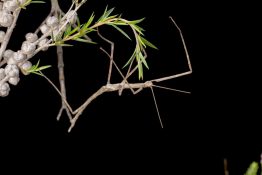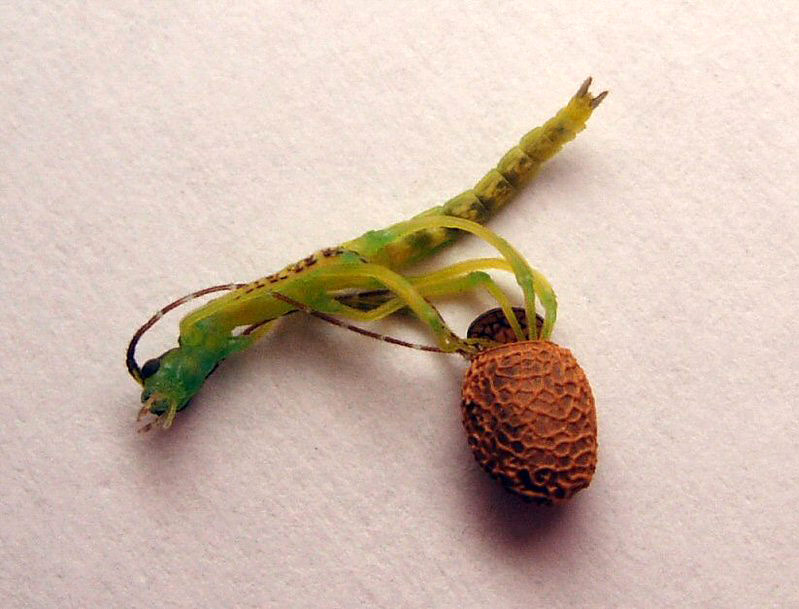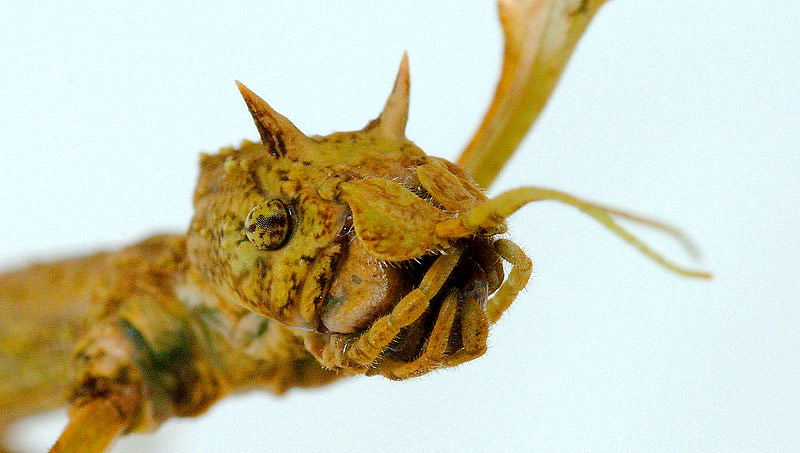Walkingsticks
 Order: Phasmatodea (walkingsticks)
Order: Phasmatodea (walkingsticks)
Family: Phasmatidae, Diapheromeridae, and Pseudophasmatidae
How to identify:
Walkingsticks have a long, slender body with six long legs. Though some walkingsticks have wings, all but one species in the USA are wingless (Borror & White, 1970). They range in length from 1 to 12 inches and closely resemble a tree twig or stick. Walking sticks are usually brown or green in color, mimicking their surroundings (National Geographic, 2022).
Advanced ID: The species in North America have an elongated, slender, twig-like body with wings that are either much reduced or completely absent. The tarsi are usually 5-segmented. Walkingsticks lack tympana. They have a short, 1-segmented cerci and a short, concealed ovipositor (Triplehorn & Johnson, 2005).
Ecology
Metamorphosis Type: Simple metamorphosis: egg, nymph (or naiad if aquatic), adult (no pupa stage). Nymphs look similar to adults without wings (e.g., crickets, dragonflies).
Geographic Range: Walkingsticks are primarily found in temperate and tropical regions on every continent except Antarctica (National Wildlife Federation, 2022).
Habitat: Walkingsticks are usually found on trees or shrubs in temperate regions as well as in the tropics and subtropics. Walking sticks thrive in forests and grasslands where their twig-like mimicry provides protective value (National Geographic, 2022).
Trophic Level: Herbivore: consumes plants
Food: Walkingsticks have mandibulate mouthparts. This means their mouth anatomy is optimal for cutting and chewing. They use their mouths to cut and chew the leaves of various shrubs and trees.
Why should we care?
Human Uses: Walkingsticks have environmental benefits, such as foliage pruning and encouragement of new plant growth. Their consumption of plants decreases the growth of early successional plants, and their feces enhances soil nutrients for later successional plants. (Cipollini, n.d.).
Conservation Status: Walkingsticks are vulnerable due to habitat destruction, pesticide use, and human collection for the pet trade. (National Wildlife Federation, 2022). To help protect walkingsticks, humans can focus on habitat preservation and eliminating the pet trade.
Did you know?
- Walkingsticks reproduce via parthenogenesis, a form of asexual reproduction (i.e., females do not need males to reproduce). Eggs are scattered on the ground once a year, overwinter, and then hatch the second year after they are laid (Triplehorn & Johnson, 2005).
- Walkingsticks mimic twigs in shape, color, and behavior by swaying back and forth and walking slowly to camouflage themselves from predators (National Wildlife Federation, 2022).
Images Cited
Photo 1: Catching The Eye. 2012. Creative Commons License | Link
Photo 2: Pavel Kirillov. 2015. Creative Commons License | Link
Photo 3: Pavel Kirillov. 2014. Creative Commons License | Link
Photo 4: Laurence Livermore. 2007. Creative Commons License | Link
Photo 5: Pavel Kirillov. 2017. Creative Commons License | Link
Photo 6: Josh More. 2013. Creative Commons License | Link
Researcher’s Biography
Jamie Trechock
Completed this research within Dr. Shelly Thomas’ Entomology course
Suggested Citation:
Trechock, Jamie. (2022). Walkingsticks. Rowan University Arboretum. https://arboretum.rowan.edu/learn/explore-insects/walkingsticks/
Questions to Explore
- How does the effectiveness of walkingstick camouflage vary across different plant species and habitats?
- What is the role of behavioral mimicry, such as swaying, in enhancing walkingstick camouflage, and how can this be leveraged in human uses?
- How does the unique digestive system of walkingsticks allow them to process and tolerate the leaves of various plants, including those with defensive compounds?
- What factors influence the life cycle, population dynamics, and distribution of different walking stick species?
- Are there any unique adaptations in walkingsticks that allow them to survive in specific habitats or geographic regions?
Citations
Borror, J. B. & White, E. R. (1970). Insects. Houghton Mifflin Company.
Cipollini (n.d.). The walking stick bug and its significance to the environment. | Link
National Geographic. (2022). Stick insects. | Link
National Wildlife Federation. (2022). Walking Sticks. | Link
Triplehorn, A. C. & Johnson, F. N. (2005). Borror and DeLong’s introduction to the study of insects. Peter Marshall.






